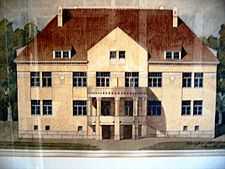Karl Lindahl (architect)

Karl Håkan Einar Lindahl (10 March 1874 – 12 April 1930) was a Finnish architect of Swedish origin.
Life and career
Born in Jönköping, Lindahl studied architecture at the Helsinki Polytechnic Institute, graduating in 1898.[1] Beginning in 1900, he practised as an architect in Helsinki. Initially he was an early proponent of the National Romantic or Art nouveau style, for many years in partnership with Walter Thomé.[2] Then, like many of his contemporaries, he changed to a neo-classical style.[3] His work includes several public buildings, residences in Helsinki and some country houses in Suvisaaristo, but also many industrial buildings.[3]
In 1907, Lindahl was sent with veterinarian Oskar von Hellens on a fact-finding tour of foreign abattoirs to enable incorporation of best practices in the new Helsinki slaughterhouse.[4]
He died in Helsinki.
Selected works
- (with Walter Thomé) Oulu Market Hall (1901)
- (with Walter Thomé) Polytechnic Students' Union, also called the Sampo Building and now known as the Vanha Poli (old poly), Lönnrotinkatu 29, Helsinki (1903),[1][3][5][6][7][8][9][10][11][12] with original furniture by Count Louis Sparre.[13] In the 1990s an interior courtyard was added and the building has since been a hotel.[14]
- (with Walter Thomé) Enso Gutzeit factory headquarters, Kotka (1903)[3]
- (with Walter Thomé) Headquarters of Otava publishing company, Uudenmaankatu 10, Helsinki (1905)[1][3][15][16]
- Söderkulla mansion, Söderkulla, now part of Sipoo (1908)[17]
- Helsinki Workers' House, Paasivuorenkatu 5 A (1908, 1924)[3]
- Gunnarsberg villa, Grankulla (1910)[3]
- Finnish business centre in Viipuri (1911)[1]
- (with Walter Thomé) Headquarters of Suomi insurance company, Eteläesplanadi 2, Helsinki (1912), now headquarters of UPM[1][3]
- School, Liedakkala (1915)[18]
- Hahkiala estate at Hauho (1916)[1]
- Sugar refinery, Salo (1919)[1]
- Finlayson factory power plant, Forssa (1921)[3]
- Lindö estate at Ekenäs (1923)[1]
- Industrial and town buildings including a school, Varkaus (1924)[19]
- Ahlström pulp mill, Karhula, now part of Kotka (1927)[3][20]
- Korkeakoski power plant (1927)[3]
Buildings designed by Karl Lindahl




References
- ↑ 1.0 1.1 1.2 1.3 1.4 1.5 1.6 1.7 T. Stz., "Lindahl, Karl Håkan Einar", Nordisk familjebok, Owl Edition, volume 37 Supplement: L – Riksdag, col. 197 (Swedish)
- ↑ Fabienne Chevallier, L'œuvre d'Eliel Saarinen en Finlande et la question de l'architecture nationale de 1898 à 1909, Histoire de l'art 12, Paris: Sorbonne, 2001, ISBN 9782859444235, p. 165 (French)
- ↑ 3.0 3.1 3.2 3.3 3.4 3.5 3.6 3.7 3.8 3.9 3.10 Patrick Eriksson, "Lindahl, Karl", Uppslagsverket Finland, retrieved 30 January 2013.
- ↑ Marjatta Hietala, "Hygiene and the Control of Food in Finnish Towns at the Turn of the Century: A Case Study from Helsinki", in The Origins and Development of Food Policies in Europe, ed. John Burnett and Derek J. Oddy, London/New York: Leicester University, 1994, ISBN 9780718514747, pp. 113–29, p. 126.
- ↑ John Howard, Art Nouveau: International and National Styles in Europe, Critical introductions to art, Manchester/New York: Manchester University Press, 1996, ISBN 9780719041600, p. 181.
- ↑ John Boulton Smith, The Golden Age of Finnish Art: Art Nouveau and the National Spirit, Helsinki: Otava, 1976, ISBN 9789511022831, p. 45.
- ↑ James Maude Richards, A Guide to Finnish Architecture, New York: Praeger, 1967, OCLC 346187, p. 67.
- ↑ Now the Light Comes from the North: Art Nouveau in Finland, ed. Ingeborg Becker and Sigrid Melchior, tr. Michael Loughridge, exhibition catalogue, Berlin: Bröhan Museum, [2002], ISBN 9783980789417, p. 66.
- ↑ Innovation versus Tradition: The Architect Lars Sonck: Works and Projects 1900–1910, tr. Jüri Kokkonen, Suomen Muinaismuistoyhdistyksen aikakauskirja 96, Helsinki: [Suomen Muinaismuistoyhdistys], 1991, ISBN 9789519056999, p. 56.
- ↑ Chevallier, p. 37.
- ↑ Keijo Petäjä, Suomen Rakennustaiteen Museo, Helsinki: arkkitehtuuriopas / Helsingfors; architectural guide, 2nd ed. Helsinki: Otava, 1965, OCLC 23549141, p. 93.
- ↑ Illustration, Nils Erik Wickberg, Finnish Architecture, Helsinki: Otava, 1962, OCLC 2807511, p. 114.
- ↑ Dekorative Kunst 11 / Die Kunst 8: Angewandte Kunst (1903) pp. 136, 152 (German)
- ↑ Patrick Eriksson, "Thomé, Valter", Uppslagsverket Finland, retrieved 31 January 2013.
- ↑ Valter Thomé, "Förlagsaktiebolagets Otavas hus i Helsingfors", Arkitekten Volume 6, issue 6, September 1908, pp. 79–80 (Swedish)
- ↑ Helsinki, Espoo, Kauniainen, Vantaa: An Architectural Guide, ed. Arvi Ilonen, Suomen Rakennustaiteen Museo, tr. Laura Siilasvuo, Helsinki: Otava, 1990, ISBN 9789511107620, p. 57.
- ↑ historiaa, Söderkullan kartano (Finnish)
- ↑ Liedakkalan koulu, peda.net (Finnish)
- ↑ Hannu Itkonen, Varkaus and Its People: A Hundred Years, Suomalaisen Kirjallisuuden Seuran toimituksia 1057, Helsinki: Suomalaisen Kirjallisuuden Seura, [2005], ISBN 9789517467896, pp. 61, 56, 139.
- ↑ Malcolm Quantrill, Finnish Architecture and the Modernist Tradition, London/New York: E & FN Spon, 1995, ISBN 9780419195207, p. 183.
Further reading
- Jonathan Moorhouse, Michael Carapetian and Leena Ahtola-Moorhouse. Helsinki Jugendstil architecture, 1895–1915. Helsinki: Otava, 1987. ISBN 9789511083825